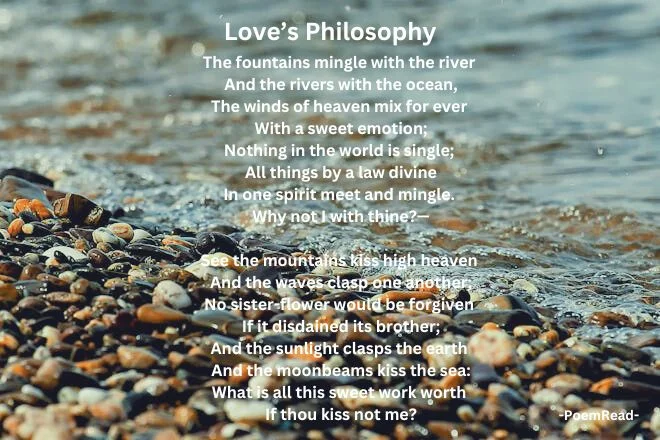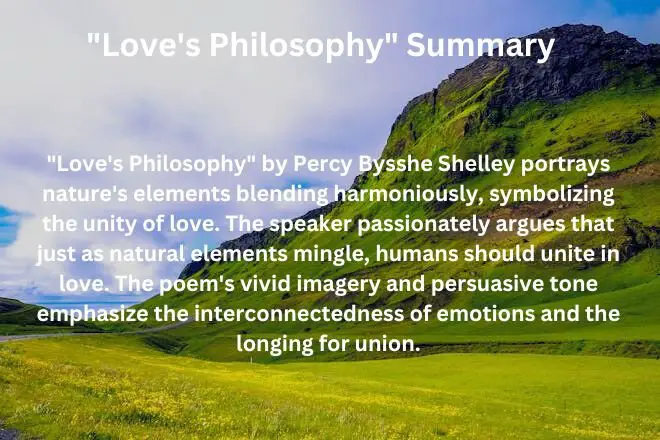
Enter the enchanting world of Percy Bysshe Shelley’s “Love’s Philosophy” through this article. In this lyrical masterpiece, Shelley weaves together nature, desire, and logic. The poem employs a seductive form of reasoning, suggesting that love is a divine law. This idea is illustrated through the interconnectedness observed in the world. Through vivid imagery and poetic persuasion, Shelley invites us to recognize the irresistible force of love and the longing for union. Let’s unravel the intricacies of this timeless piece.
Love’s Philosophy
The fountains mingle with the river
And the rivers with the ocean,
The winds of heaven mix for ever
With a sweet emotion;
Nothing in the world is single;
All things by a law divine
In one spirit meet and mingle.
Why not I with thine?—
See the mountains kiss high heaven
And the waves clasp one another;
No sister-flower would be forgiven
If it disdained its brother;
And the sunlight clasps the earth
And the moonbeams kiss the sea:
What is all this sweet work worth
If thou kiss not me?
Content
- About the Author: Percy Bysshe Shelley
- Subject of Love's Philosophy
- Context of Love's Philosophy
- Theme and Tone of Love's Philosophy
- Persona
- Setting
- Form and Structure of Love's Philosophy
- Line-by-Line Analysis of Love's Philosophy
- Poetic and Literary Devices Used in Love's Philosophy
- Implications and Meanings of Love's Philosophy
- Interactive Summary of Love's Philosophy
About the Author: Percy Bysshe Shelley
Percy Bysshe Shelley, a prominent figure in English Romantic poetry, was born on August 4, 1792, in England. Known for his lyrical and revolutionary style, Shelley’s works often explored themes of love, nature, social justice, and the human spirit. He was a passionate advocate for freedom of thought and expression, which is reflected in his bold and visionary poetry.
Despite facing criticism and controversy during his lifetime due to his unconventional views on religion, politics, and society, Shelley’s literary contributions have since been widely celebrated and recognized. His notable works include “Ozymandias,” “To a Skylark,” “Ode to the West Wind,” and, of course, “Love’s Philosophy.”
Tragically, Shelley’s life was cut short at the age of 29 in a boating accident in 1822. However, his legacy as a radical thinker and poetic genius continues to inspire generations of readers and writers, solidifying his place as a key figure in English literature and Romanticism.
Subject of Love’s Philosophy
The subject of “Love’s Philosophy” revolves around the interconnectedness of all elements in the world, emphasizing the universal nature of love. Percy Bysshe Shelley uses vivid imagery from nature to convey the idea that just as natural elements blend and unite harmoniously, human beings should also come together in love and unity. The poem explores the notion that love transcends individual boundaries and is part of a larger, divine order.
Shelley portrays the natural blending of elements, like fountains merging with rivers and winds intertwining with emotions. This illustrates the inherent unity of the world. The speaker’s heartfelt plea for unity with their beloved reflects this harmony, emphasizing how human emotions are interconnected with the broader natural order.
The subject of “Love’s Philosophy” explores the timeless theme of love’s universality. It urges readers to recognize the inherent connection between all things and embrace the power of love to unite and harmonize existence.
Context of Love’s Philosophy
Percy Bysshe Shelley’s “Love’s Philosophy” takes place during the Romantic era, which was characterized by a deep appreciation for nature, emotions, and individualism. Shelley, a prominent Romantic poet, wrote the poem in 1819, a time marked by social and political upheavals in Europe.
During the Romantic era, there was a strong belief in the interconnectedness of humanity with nature and the divine. Romantic poets often explored themes of love, longing, and the sublime, seeking to capture the beauty and power of natural elements in their works.
Shelley’s “Love’s Philosophy” reflects these Romantic ideals by using nature’s imagery to convey the speaker’s longing for love and unity. The Romantic movement’s emphasis on feelings, intuition, and the interconnectedness of all living things has an influence on the poem’s context.
Additionally, the political and social climate of Shelley’s time, with revolutions and societal changes underway, may have influenced the poem’s themes of unity and harmony. The context of “Love’s Philosophy” includes the romantic fascination with nature. It also involves the broader historical backdrop of a changing world. This adds depth to Shelley’s exploration of love and interconnectedness.
Theme and Tone of Love’s Philosophy
The theme of “Love’s Philosophy” by Percy Bysshe Shelley revolves around the idea of interconnectedness and the universal nature of love. The poem explores the concept that all elements in the world, both natural and human, are connected through a divine law or order. This theme is conveyed through vivid imagery from nature, such as rivers merging, winds mixing, and mountains kissing high heaven, to emphasize the seamless unity inherent in the world.
The tone of the poem is passionate and persuasive. The speaker uses these natural images and metaphors to convince the beloved of the necessity of their union, drawing parallels between the harmonious blending of elements in nature and the longing for unity in human relationships. The tone reflects the Romantic ideals of intense emotion and the belief in the spiritual interconnectedness of all things.
Overall, the theme and tone of “Love’s Philosophy” convey a deep sense of longing for love and unity, portraying love as a universal force that binds all existence together. The passionate tone and evocative imagery create a compelling argument for the interconnectedness of human emotions with the broader cosmic order.
Persona
The speaker in “Love’s Philosophy” embodies both the role of a passionate lover and a persuasive philosopher. Their voice oscillates between tender longing and logical reasoning. This persona is deeply attuned to nature, drawing inspiration from the elements like fountains, rivers, winds, mountains, and waves.
They address their beloved directly, urging them to recognize the universal law of interconnectedness. The persona’s emotions are noticeable, and their desire for union is powerful. They are both a romantic dreamer and a pragmatic seeker of truth.
Setting
The setting of the poem is twofold: the expansive natural world and the intimate connection between two individuals. The natural setting is described as timeless and vast, including elements like flowing rivers, expansive skies with winds, towering mountains, and the embracing waves of the sea. These natural elements symbolize a timeless witness to the drama of love.
On the other hand, the intimate setting is more intangible and resides within the hearts of the speaker and their beloved. It’s the charged atmosphere between two people, the unspoken desires, and the shared emotions. This intimate setting goes beyond physical spaces; it can be felt in moonlit gardens, by rushing streams, or within the inner depths of one’s soul. It is wherever love’s philosophy takes hold and blossoms, transcending mere physical surroundings.
Form and Structure of Love’s Philosophy

“Love’s Philosophy” by Percy Bysshe Shelley is a concise poem with a clear structure. Divided into two eight-line stanzas, it follows a simple yet effective ABABCDCD rhyme scheme. This consistent pattern creates a sense of musicality and reinforces the central arguments.
The poem doesn’t strictly adhere to a single meter, but its trochaic tetrameter base with some variations adds a layer of dynamism. This interplay between structure and slight variations reflects the passionate yet logical arguments the speaker presents about love’s natural order.
Rhyme Scheme
The rhyme scheme is ABABCDCD, where each letter represents a line’s end rhyme. This consistent pattern employs perfect/full rhymes, lending a harmonious quality to the verses.
A – The fountains mingle with the river (1)
B – And the rivers with the ocean, (2)
A – The winds of heaven mix forever (3)
B – With a sweet emotion; (4)
C – Nothing in the world is single; (5)
D – All things by a law divine (6)
C – In one spirit meet and mingle. (7)
D – Why not I with thine? (8)
In this scheme, each letter corresponds to a line’s end rhyme. The poem’s consistent pattern of perfect/full rhymes contributes to its lyrical quality. The meter maintains a rhythmic flow, emphasizing the theme of interconnectedness between love and nature. Shelley’s eloquence and simplicity make this poem a timeless exploration of human emotion and the universe’s intricate design.
Enjambment
Shelley employs enjambment, where a sentence or phrase flows from one line to the next without a pause. This technique creates a sense of continuity, emphasizing the interconnectedness of love and nature. For instance: “The fountains mingle with the river” (line 1) flows seamlessly into “And the rivers with the ocean” (line 2).
Imagery
The poem’s imagery is vivid and evocative. Each stanza presents a natural phenomenon—fountains, rivers, winds, mountains, waves, flowers, sunlight, and moonbeams—interacting harmoniously. These elements serve as metaphors for love’s union. The physical world becomes a canvas for emotional expression.
Punctuation and Rhythm
Shelley’s use of punctuation is deliberate. Commas and semicolons guide the reader, allowing for pauses and emphasizing key moments. The rhythm is gentle, almost like a whispered persuasion. The poem flows smoothly, inviting the reader to join the lover’s plea.
Meter in “Love’s Philosophy”
The meter in “Love’s Philosophy” is mainly trochaic tetrameter. This means most lines consist of four “feet” with a stressed syllable followed by an unstressed one (da-DUM, da-DUM, da-DUM, da-DUM). This rhythmic pattern creates a confident and marching-like tone in the poem.
However, there are some deviations. The opening line has an extra unstressed syllable, giving it a casual feel. Also, the last line in each stanza shortens to trochaic trimeter (three feet), highlighting the final thought. These variations prevent monotony and reflect the complexity of love.
Line-by-Line Analysis of Love’s Philosophy
Stanza 1
"The fountains mingle with the river"
"And the rivers with the ocean,"
"The winds of heaven mix for ever"
"With a sweet emotion;"
"Nothing in the world is single;"
"All things by a law divine"
"In one spirit meet and mingle."
"Why not I with thine?—"
In this first stanza, Shelley introduces the theme of interconnectedness in nature, using imagery like fountains, rivers, and winds to symbolize unity. The repeated phrases “mingle,” “mix,” and “meet and mingle” emphasize the blending and merging of elements, while the closing question highlights the speaker’s desire for emotional connection and unity with the beloved.
The fountains mingle with the river
This line introduces the idea of blending and merging, where smaller elements (fountains) combine seamlessly with larger ones (river). It symbolizes the natural inclination of elements to come together, reflecting the speaker’s desire for unity and connection.
And the rivers with the ocean,
Continuing the theme of merging, this line extends the metaphor to a grander scale, where rivers join and become part of the vast ocean. It emphasizes the interconnectedness of all things in nature.
The winds of heaven mix for ever
In this line, the continuous blending of heavenly winds symbolizes an everlasting cycle of connection and interdependence. It conveys a sense of timelessness and continuity in the natural world.
With a sweet emotion;
This phrase adds a feeling of sweetness and emotional depth to the merging of elements. It suggests that there is beauty and joy in unity, echoing the Romantic notion of nature’s emotional resonance.
Nothing in the world is single;
This line asserts a fundamental truth about the interconnected nature of existence. It implies that isolation or singularity is unnatural, emphasizing the universal principle of unity and harmony.
All things by a law divine
The reference to a divine law suggests a higher order or purpose governing the interconnectedness of all things. It introduces a spiritual dimension to the poem, highlighting the idea of cosmic unity.
In one spirit meet and mingle.
The unity of all things in a single spirit reinforces the theme of interconnectedness. It suggests that there is a common essence or energy that binds all existence together, transcending physical boundaries.
Why not I with thine?—
The speaker questions why human love should not follow the same pattern of unity seen in nature. It expresses a longing for emotional connection and intimacy with the beloved, mirroring the interconnectedness found in the natural world.
Stanza 2
"See the mountains kiss high heaven"
"And the waves clasp one another;"
"No sister-flower would be forgiven"
"If it disdain'd its brother;"
"And the sunlight clasps the earth"
"And the moonbeams kiss the sea:"
"What is all this sweet work worth"
"If thou kiss not me?"
In the second stanza, Shelley continues the theme of interconnectedness through vivid imagery of mountains, waves, flowers, sunlight, and moonbeams. These natural elements symbolize unity and harmony, while the rhetorical questions provoke reflection on the value of love and connection. The stanza ends with a poignant plea for love’s reciprocity, reinforcing the central theme of the poem.
See the mountains kiss high heaven
This line employs vivid imagery of mountains reaching toward the sky, symbolizing a lofty and transcendent love. It portrays love as something grand and sublime, aspiring to reach divine heights.
And the waves clasp one another;
The image of waves embracing signifies the natural inclination of elements to come together and connect. It reinforces the theme of unity and harmony in nature.
No sister-flower would be forgiven
This line suggests that even nature’s smallest components seek connection and harmony. It underscores the idea that love is universal and extends to all living things, portraying love as a binding force.
If it disdain’d its brother;
Rejecting unity or connection is depicted as unnatural and unforgivable. It emphasizes the importance of embracing love and interconnectedness, even among seemingly different or distant entities.
And the sunlight clasps the earth
The imagery of sunlight embracing the earth conveys a sense of warmth, nourishment, and life. It symbolizes the nurturing aspect of love and the positive impact it can have on the world.
And the moonbeams kiss the sea:
This line portrays celestial bodies engaging in acts of love, highlighting the beauty and harmony found in natural connections. It reinforces the idea that love is universal and transcends earthly boundaries.
What is all this sweet work worth
The rhetorical question challenges the value of nature’s harmonious unity if human love remains unfulfilled. It prompts reflection on the significance of emotional connection and unity in both nature and human relationships.
If thou kiss not me?
The poem concludes with a direct plea for love and union, emphasizing the speaker’s desire for connection and emotional intimacy with the beloved. It reinforces the central theme of love’s philosophy and the longing for unity and reciprocity.

Poetic and Literary Devices Used in Love’s Philosophy
Imagery
The poem is filled with vivid imagery that appeals to the senses and creates powerful visualization. Examples include “fountains mingle with the river,” “mountains kiss high heaven,” and “moonbeams kiss the sea.” These images create a sense of unity and harmony in nature, reinforcing the theme of interconnectedness.
Metaphor
Shelley uses metaphorical language to compare natural elements to human emotions and relationships. For instance, “The winds of heaven mix forever with a sweet emotion” metaphorically links heavenly winds to the sweet emotion of love, blending the physical and emotional realms.
Personification
Nature’s elements are personified throughout the poem, giving them human-like qualities and agency. For example, “the winds of heaven mix” and “the sunlight clasps the earth” personify natural forces, creating a sense of intimacy and interaction.
Rhetorical Questions
The poem is punctuated with rhetorical questions that engage the reader and provoke contemplation. Lines such as “Nothing in the world is single; / All things by a law divine” and “What is all this sweet work worth / If thou kiss not me?” prompt reflection on the themes of interconnectedness and love.
Enjambment
Shelley employs enjambment, where sentences or phrases flow from one line to the next without a pause. This technique creates a sense of continuity and fluidity, mirroring the interconnected nature of the poem’s themes.
Repetition
The repetition of phrases like “mingle,” “mix,” and “kiss” throughout the poem emphasizes the theme of unity and interconnectedness. These repeated words act as refrains, reinforcing the central message of love’s philosophy.
Rhyme Scheme
The poem follows an ABABCDCD rhyme scheme in each stanza, contributing to its musicality and rhythmic flow. The consistent rhyme scheme adds to the poem’s aesthetic appeal and enhances its emotional resonance.
Alliteration
Shelley employs alliteration, where words with the same initial consonant sound are used in close proximity. For instance, “see the mountains kiss high heaven” and “waves clasp one another.” This device adds a musical quality to the poem and accentuates key phrases.
Symbolism
Natural elements such as rivers, oceans, mountains, winds, and sunlight are symbolic representations of larger themes like unity, love, and divine order. They serve as potent symbols that deepen the poem’s meaning and imagery.
Emotive Language
Throughout the poem, Shelley uses emotive language to convey the speaker’s passionate longing for love and unity. Phrases like “sweet emotion,” “high heaven,” and “moonbeams kiss the sea” evoke strong emotions and create a heartfelt tone.
Implications and Meanings of Love’s Philosophy
“Love’s Philosophy” suggests that love is a fundamental aspect of the human experience and that it should be reciprocated for true harmony and fulfillment. The poem implies that just as nature seeks unity and harmony, so too should love be united and shared. It conveys a sense of longing and desire, highlighting the universal nature of love and the need for it to be reciprocated in order to find true happiness.
Interactive Summary of Love’s Philosophy
“Love’s Philosophy” by Percy Bysshe Shelley explores the universal longing for love and the belief that love should be reciprocated. Through the use of vivid natural imagery and metaphors, the poem emphasizes the interconnectedness of all things and the necessity of unity in love.
The regular rhyme scheme and minimal punctuation contribute to the musicality and flow of the poem. Overall, “Love’s Philosophy” conveys a passionate plea for reciprocated love and highlights the beauty and harmony found in nature as evidence of its importance.
If Percy Bysshe Shelley’s “Love’s Philosophy” intrigues you, you might also enjoy reading our analysis of Robert Frost’s “Fire and Ice.” Both poems explore themes of passion and desire, although in different ways—one talks about love and interconnectedness, while the other considers the end of the world using fire and ice.
RELATED POSTS
View all



